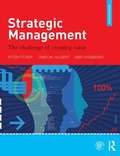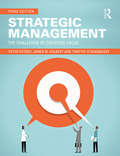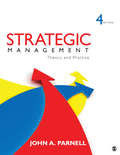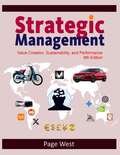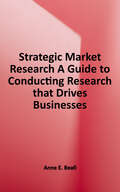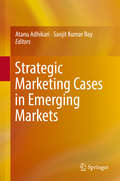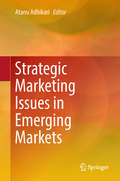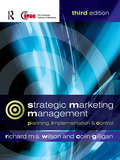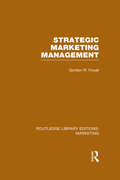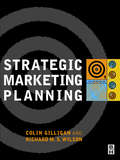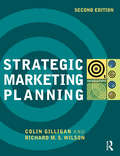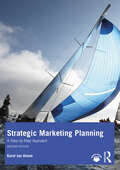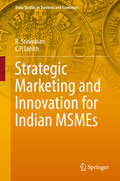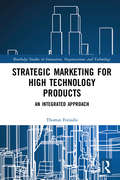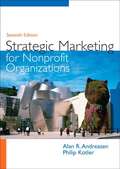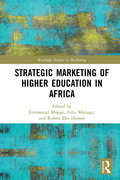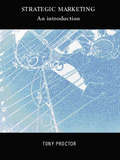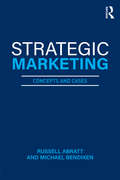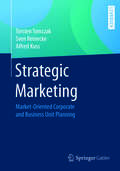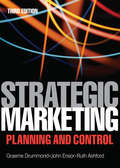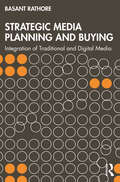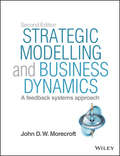- Table View
- List View
Strategic Management: The Challenge of Creating Value
by Peter Fitzroy James M. Hulbert Abby GhobadianStudents trying to navigate the strategy jungle may lose sight of the fact that strategic management is about creating value in an organization. Understanding strategic management is a core part of all business qualifications and this textbook brings a new and easy-to-follow understanding of this vital business function. In addition to walking the student through the basics of the subject, the authors provide an array of analytical tools to help facilitate a thorough understanding of strategic management. The book addresses thoroughly the impact of financial markets on a firm's strategic capabilities, as well as looking at other challenging environmental factors. Aided by an array of student-friendly features, such as: learning objectives, 'strategic management in practice' case studies and review questions in each chapter, Strategic Management will help students to excel in their strategic management classes and better prepare them for the real business world. A comprehensive companion website, containing a wealth of supplementary materials for students and lecturers alike, is available at: http://www.routledge.com/cw/fitzroy.
Strategic Management: The Challenge of Creating Value
by Peter Fitzroy James M. Hulbert Timothy O'ShannassyStrategy is often the capstone class in a business education - dealing with the big questions of what companies decide to do - innovate, diversify, acquire or even to employ a range of these strategies. Benefitting from an international author team, the latest edition of this textbook stands out in its global perspective. With an emphasis on value creation, integration of financial considerations alongside coverage of areas that are often missed in competitor texts, such as financial implications for strategy, corporate governance and business ethics. The book also integrates a wide range of in-depth case studies, including Siemens AG, Intel, the Volkswagen Group, PerkinElmer and the Tata Group. Supplemented by a wide range of cutting edge online case studies and other internet resources, this text will provide students and their instructors with everything they need to succeed in this tough environment.
Strategic Management: Theory and Practice
by John A. ParnellIn Strategic Management: Theory and Practice, Fourth Edition, John A. Parnell leads readers through detailed, accessible coverage of the strategic management field. Concise and easy to understand chapters address concepts sequentially, from external and internal analysis to strategy formulation, strategy execution, and strategic control. Rather than relegating case analysis to a chapter at the end of the book, Parnell aligns each chapter's key concepts with 25 case analysis steps. Current examples and high interest real-time cases, largely drawn from The Wall Street Journal and Financial Times, illustrate the key role of strategic management in the United States and around the world.
Strategic Management: Value Creation, Sustainability, and Performance
by G. Page West IIIThis book combines theory and practice in a particularly effective approach to the study of strategic management. Emphasizing strategy development in highly competitive environments, it applies traditional theoretical principles and analytical frameworks to today's dynamic business climate. It uses value creation and resource-based sustainability as central concepts to integrate ideas from cover to cover. This enables a broad discussion of stakeholders and organizational goals, in-depth exploration of the foundation of superior long term performance, and shows how strategy content areas are all centrally related. The book is also distinguished by its very practical approach. Chapters provide guidance on actually putting strategy frameworks to use (e.g., steps to conduct an industry analysis, how to do a resource analysis, how to conduct a value chain analysis) along with examples of how to do so. Fresh material from the news brings the theory and the practice alive for students. Classroom-tested and peer-reviewed, the author employs an engaging writing style that appeals to students and instructors alike.
Strategic Management: Value Creation, Sustainability, and Performance
by Page WestStrategic Management 8e combines theory and practice, updated into 2024, in a unique and integrative approach to the study of strategic management. For instructors it emphasizes the value chain and resource-based sustainability as central integrating strategy concepts. For students it draws on the twin "strategic imperatives" of value creation and opportunity recognition as recurrent themes that help to sync ideas from cover to cover. Together these integrating mechanisms focus on the tension that exists between competing effectively in the present while preparing to compete effectively over the long run. Examples from highly competitive environments illustrate how traditional theoretical principles and analytical frameworks apply to today's dynamic business climate. Grounded in contemporary strategic management theory, the book also exhibits a very practical approach. An early chapter is devoted exclusively to the key question of Strategy and Performance, which enables richer classroom discussions moving forward. Other chapters provide step-by-step guidance on actually putting strategy frameworks to use (e.g., how to conduct an industry analysis, how to do a resource analysis, how to conduct a value chain analysis) along with clear examples for each. Classroom-tested and peer-reviewed, the author employs an engaging writing style that appeals to students and instructors alike. This 8th edition updates the previous edition and continues its tradition of providing the most current industry and company data of any strategy text in the market.
Strategic Market Research: A Guide to Conducting Research That Drives Businesses
by Anne E. BeallFor a company to embrace market research as a facilitator of change, it must be willing to take the approach that makes the most impact on its organization. In this guide, author Anne Beall shares her unique approach for conducting strategic market research. With more than 25 years of experience, Beall details the strategic principles she has developed that impact the way in which market research can inspire and change an organization. It all begins with the following steps: Identifying the strategic questions that will help a business; Using the right research techniques to answer these questions; Obtaining the level of depth required to have insight; Reading the nonverbal communications of research respondents; Identifying the emotional aspects of human behavior; Using statistical analyses to understand what drives markets; Going beyond the data to interpret the results and make strategic recommendations. In addition to addressing both qualitative and quantitative research, Strategic Market Research provides real-life examples illustrating the application of these concepts in various scenarios, including businesses and non-profit organizations.
Strategic Marketing Cases in Emerging Markets
by Sanjit Kumar Roy Atanu AdhikariThis is a teaching companion to the case studies provided in the book 'Strategic Marketing Cases in Emerging Markets' and is intended to help teachers and trainers follow a pedagogic line by using the case studies to develop a critical understanding of the service business scenarios and strategies for marketing in emerging markets. The authors provide extensive teaching notes for each of the cases, covering the pedagogy of the case study, the prerequisites to understanding it, case-specific teaching objectives, a suggested teaching approach, and a case synopsis. Each case is then rounded out with suggested discussion questions and concise answers, as well as additional reading to enhance the teaching and learning experience in the classroom.
Strategic Marketing Issues in Emerging Markets
by Atanu AdhikariThis book presents a collection of articles addressing a range of marketing strategies unique to emerging economies. It describes the component of strategic and tactical marketing, including the marketing mix, segments and targeting, product and market orientation, employing the Internet and social media, penetration and loyalty strategies and innovation, and other strategy issues in the marketing context. In addition, the book focuses on creating, communicating, and delivering customer value to emerging market consumers through diverse marketing strategies, processes, and programs in the context of emerging markets’ dynamics, consumer diversity, and competitors. Bringing together contributors from industry and academia to explore key marketing issues prevalent in India and other emerging economies, the book offers a unique and insightful read for a global audience."This book, edited by Dr. Atanu Adhikari, offers important analytical and managerial insights into consumer behavior, firm strategy, market dynamics and marketing instruments (price, promotion, distribution and product). While marketing and management disciplines have developed useful empirical generalizations, the context is critical. This book does exactly that -- place the generalized results in the context of emerging markets and India. Accordingly, this is a valuable resource for scholars and practitioners." -- Dr. Gurumurthy Kalyanaram, Professor, City University of New York, USA and Tata Institute of Social Sciences, Mumbai, India; US Editor, International Journal of Learning and Change; and President, MIT South Asian Alumni Association"This book is a must-read for anyone interested in marketing to less-developed countries. While the focus of the chapters is on India, the lessons learned can be generally applied. The 32 chapters represent comprehensive coverage of nearly every topic related to marketing with many examples. Any manager interested in doing business in emerging markets, Professors who want a better knowledge of these markets, or students who want an excellent reference should acquire this book." -- Dr. Russell S. Winer, William Joyce Professor of Marketing, Stern School of Business, New York University, USA
Strategic Marketing Management
by Colin Gilligan Richard M.S. WilsonThis third edition of Strategic Marketing Management confirms it as the classic textbook on the subject. Its step- by- step approach provides comprehensive coverage of the five key strategic stages: * Where are we now? - Strategic and marketing analysis * Where do we want to be? - Strategic direction and strategy formulation * How might we get there? - Strategic choice * Which way is best? - Strategic evaluation * How can we ensure arrival? - Strategic implementation and control This new revised and updated third edition has completely new chapters on 'The Nature and Role of Competitive Advantage' and 'The Strategic Management of the Expanded Marketing Mix', and extensive new material covering: * The changing role of marketing * Approaches to analysing marketing capability * E-marketing * Branding * Customer relationship management * Relationship management myopia * The decline of loyalty The book retains the key features that make it essential reading for all those studying the management of marketing - a strong emphasis on implementation, up to date mini cases, and questions and summaries in each chapter to reinforce key points. Widely known as the most authoritative, successful and influential text in the sector, the new edition remains an irreplaceable resource for undergraduate and graduate students of business and marketing, and students of the CIM Diploma.
Strategic Marketing Management (Routledge Library Editions: Marketing)
by Gordon FoxallThis book considers marketing management within the overall corporate system of business policy-making, strategic planning and the implementation and control of effective plans. The information requirements of marketing management are highlighted and the marketing information system concept is developed within the framework of managerial information systems. In the chapters which deal with the elements of the marketing ‘mix’, the interrelated nature of these variables is emphasized. The book illustrates how the successful marketing manager can master each ‘weapon’ in the marketing ‘armoury’ and how (s)he can integrate those weapons to achieve the right mix for each product. The accent on integrated marketing continues in the final section where differentiated marketing is presented as an integrative framework and where the systematic control of marketing operations is described. This book is for students who will one day be managers: its emphasis is therefore on what is possible in marketing management and the most effective means by which marketing objectives can be attained.
Strategic Marketing Planning
by Colin Gilligan Richard M.S. WilsonStrategic Marketing Planning concentrates on the critical 'planning' aspects that are of vital importance to practitioners and students alike. It has a clear structure that offers a digest of the five principal dimensions of the strategic marketing planning process. Leading authors in this sector, Wilson and Gilligan offer current thinking in marketing and consider the changes it has undergone over the past few years. Issues discussed include:* Emarketing, strategic thinking and competitive advantage* The significance of vision and how this needs to drive the planning process* Hypercompetition and the erosion of competitive advantage* The growth and status of relationship marketing* Each chapter contains a series of expanded illustrations
Strategic Marketing Planning
by Richard M.S. WilsonStrategic Marketing Planning concentrates on the critical planning aspects that are of vital importance to practitioners and students alike. It has a clear structure that offers a digest of the five principal dimensions of the strategic marketing planning process. Leading authors in this sector, Gilligan and Wilson offer current thinking in marketing and consider the changes it has undergone over the past few years. Updated information in this new edition includes: * Changing corporate perspectives on the role of strategic marketing activity* Changing social structures and the rise of social tribes * The significance of the new consumer and how the new consumer needs to be managed * New thinking on market segmentation* Changing routes to market* Developments in e-marketing * Changing environmental structures and pressures
Strategic Marketing Planning: A Step-by-Step Approach
by Karel Jan AlsemThis book provides a uniquely practical approach to strategic marketing planning. Combining a comprehensive overview of theory with practice, each chapter takes the reader step by step through the strategic marketing process. Beginning with situation analysis, it moves on to marketing strategy (targeting and brand positioning) and finally details the overall implementation and creation of customer values. This second edition has been fully updated to integrate both sustainability and digitalization throughout the whole strategic planning process, covering analyzing consumer needs, setting goals, choosing a brand positioning, and marketing communication. Subjects such as big data, AI, online behavioral targeting, influencer marketing, and social media are explored, accompanied by plentiful examples. A unique feature is the full integration of sustainability within normal marketing, led by a new customer value model. Strategic Marketing Planning equips the reader with the necessary tools and techniques to develop and deliver a thorough and effective marketing strategy. With a broad range of international case studies that bring the theory to life, this well-renowned text is vital reading for undergraduate and postgraduate students of marketing management and strategic marketing. It should also be of interest to marketing practitioners who want a clear overview to aid them in the planning process. Support materials include PowerPoint slides.
Strategic Marketing and Innovation for Indian MSMEs
by R. Srinivasan C. P. LohithThis book investigates how strategic marketing is influencing organizations' innovation performance. It presents a structured study conducted on micro, small and medium enterprises (MSMEs) to identify the correlation between innovation and strategic marketing in both Indian manufacturing and service organizations. Strategic marketing, which achieves excellence in organizations, is at the heart of improving productivity, profitability and market sustainability, while also supplying organizations a much sought-after competitive advantage. It has been observed that strategic marketing can significantly help any manufacturing firm to attain the required level of growth, and can specifically be used by Indian firms as a means of deriving differential advantages. Indian organizations that pursue more traditional approaches to strategy are now feeling the intense market pressure to modify their policy with respect to quality. The result has been a shift to 'Strategy with Innovation'. As market competition has again increased, providing quality products and services alone is no longer sufficient; companies are additionally expected to provide products with a touch of innovation to attract customers. This calls for innovation in terms of products, processes, technologies, systems and practically every other area of an organization, which can only be achieved by combining strategies and innovation. This book identifies the variables of strategic marketing that can help companies significantly boost their innovation performance, making it a valuable resource for students, researchers, professionals and policymakers alike.
Strategic Marketing for High Technology Products: An Integrated Approach (Routledge Studies in Innovation, Organizations and Technology)
by Thomas FotiadisIn order for High Technology (HT) companies to tackle contemporary demanding market challenges, they frequently deploy time-reduction strategies with respect to product launch. Marketing of technology related products – and especially cutting edge ones – involves a complex and multidimensional bundle of specific and unique characteristics, such as the complexity of products, the intensity of the competition, confusion and/ or fear of adoption among consumers, fast pacing changes in the external environment. The very nature of the interrelations that evolve as part of the dynamic process of strategy formulation contributes further to the formulation of a very challenging environment which is described as tumultuous, volatile and turbulent. These specific features, qualities and characteristics constitute the core of the innate need for an integrated approach that requires and depends on the cooperation and coordination of specific functional competencies. This book employs a systemic approach that accommodates the integration of specialized departmental capabilities as a fundamental prerequisite and a cornerstone for the successful navigation of high-tech organizations in their extremely competitive environments. It provides a solid and extant context of compact and consistent cognitive background that is specific to the HT strategic marketing field, and a strategic tool that utilizes, relies and is built on the turbulent environment of HT rather than just overlooking, avoiding or ignoring it, and that assumes a proactive point of view, capitalizing on characteristics specific to this field, through the provision of a strategic managerial and marketing model that is overlaid onto a reliably assessed foundation of dynamic qualities, with a long-term orientation and scope, albeit one that would be easy to apply and which will generate immediate results.
Strategic Marketing for Nonprofit Organizations (Seventh Edition)
by Philip Kotler Alan R. AndreasenStrategic Marketing for Nonprofit Organizations, Seventh Edition focuses on the impact of nonprofit marketing in the social sector and the growing intersection between nonprofit management and the business world.
Strategic Marketing of Higher Education in Africa (Routledge Studies in Marketing)
by Emmanuel Mogaji Felix Maringe Robert Ebo HinsonStrategic Marketing of Higher Education in Africa explores higher education marketing themes along the lines of understanding higher education markets, university branding and international marketing strategies, digital marketing, and student choice-making. The Higher Education landscape around the world is changing. There is global competition for students’ enrolments, universities are competing within their home market as well as in the international market, and as government funding for public universities is reducing there is pressure on universities to seek additional income by increasing their student enrolment. African universities are not an exception in this competitive market. This book is unique in providing a composite overview of strategic marketing and brand communications of higher education institutions in Africa. It recognises that there is a growing need for universities to understand the stakeholders and develop strategies on how best to engage with them effectively. Highlighting the unique characteristics, nature, and challenges of African universities, this book explores the marketisation strategies of African universities, with focus on the strategic digital marketing and brand management. The book provides significant theoretical and marketing practice implications for academics, higher-education administrators, and practitioners on how best to market higher education in Africa and reach out to prospective students. International practitioners aiming to market to Africans and start a partnership with an African university will also find this relevant in understanding the dynamics of the African market.
Strategic Marketing: An Introduction
by Tony ProctorEvery enterprise needs an understanding of the strategies used by its competitors, and a basic knowledge of how the business environment impacts on its organization before it can formulate a marketing plan. Subjects covered include: * marketing strategy* analyzing the business environment* the customer in the market place* targeting and positioning* marketing mix strategy.This fresh new introductory text examines the nature of competitive marketing strategy, highlights the importance of adopting new marketing practices in order to reap most benefit from the business opportunities of the twenty-first century, and considers how effective management of internal and external relationships is vital to action the strategy. Case studies, case histories and thought-provoking questions make this a valuable resource for students and practising managers alike.
Strategic Marketing: An Introduction
by Tony ProctorFully updated and revised to include the latest case studies and examples from a broad range of industry sectors, this second edition of Strategic Marketing: An Introduction is a concise, thorough and enlightening textbook that demonstrates how organizations can cope with a myriad of demands by better understanding themselves, their products or services, and the world around them. From assessing internal relationships to planning and implementing marketing strategies, and featuring analysis of relationship marketing and strategic alliances, Proctor uses insights from a range of key models and theoretical frameworks to illustrate how an organization can successfully take advantage of ‘strategic windows’ to improve its position. Core issues covered include: marketing strategy analyzing the business environment the customer in the market place targeting and positioning marketing mix strategy. This textbook is the complete guide to assessing and imposing a realistic and successful marketing strategy to fit an organization, its resources and objectives, and the environment in which it operates. Accessibly written and supported by a user-friendly companion website, this new edition of Strategic Marketing: An Introduction is an essential resource for all students of marketing and business and management. A companion website provides additional material for lecturers and students alike: www.routledge.com/textbooks/9780415458160/
Strategic Marketing: Concepts and Cases
by Russell Abratt Michael BendixenThis book is a unique collection of comprehensive cases that explore concepts and issues surrounding strategic marketing. Chapters explain what strategic marketing is, and then discuss strategic segmentation, competitive positioning, and strategies for growth, corporate branding, internal brand management, and corporate reputation management. With case studies from a broad range of global contexts and industries, including Burger King, FedEx, and Twitter, readers will gain a working knowledge of developing and applying market-driven strategy. Through case analysis, students will learn to: examine the role of corporate, business, and marketing strategy in strategic marketing; recognize the implications of markets on competitive space with an emphasis on competitive positioning and growth; interpret the various elements of marketing strategy and apply them to a particular real-world situation; apply sound decision-making strategies and analytical frameworks to specific strategic marketing problems and issues; apply ethical frameworks to strategic marketing situations. Strategic Marketing: Concepts and Cases is ideal for advanced undergraduate and postgraduate students, as well as those studying for an MBA or executive courses in strategic marketing or marketing management.
Strategic Marketing: Market-oriented Corporate And Business Field Planning
by Sven Reinecke Torsten Tomczak Alfred KussDieses Lehrbuch f#65533;hrt in verst#65533;ndlicher, systematischer und knapper Form in die Problemfelder der Marketingplanung ein. Sowohl die Marketingplanung auf der Unternehmens- und Gesch#65533;ftsfeldebene als auch die Planung des Marketing-Mix werden behandelt. Mit Hilfe von zahlreichen kurzen Fallbeispielen werden wesentliche Aspekte des Inhaltes veranschaulicht. Die Autoren haben in der 7. Auflage alle Kapitel #65533;berarbeitet und diverse neue Praxisbeispiele aufgenommen. Bei der Markenf#65533;hrung wurden einige Grundlagen erg#65533;nzt.
Strategic Marketing: Plannning And Control (Cim Coursebook Ser.)
by John Ensor Graeme Drummond Ruth AshfordThe completely revised and updated 3rd edition of the hugely successful Strategic Marketing: planning and control continues to provide a concise yet comprehensive synthesis of the key strategic marketing concepts. The text cuts through the complexity and jargon surrounding the subject and is tightly written to accommodate the reading time pressures on students.A clear, comprehensive and user-friendly text it provides an unrivalled digest of the tools, techniques and knowledge required to understand strategic marketing. Covering contemporary issues by exploring current developments in marketing theory and practice. It offers-• Coverage of key developments in customer relationship management, business ethics, market-led orientation and resource/asset-based approaches to internal analysis and planning• A highly exam focused approach which has been class tested and refined• A new chapter offering a ‘problem-based learning’ (PBL) approach to the subject• Thoroughly revised and updated case studies and vignettes of real world best practice throughout the textNow established as one of the leading texts in the field Strategic Marketing 3rd edition will continue to be an essential learning tool for CIM students and marketing undergraduates and postgraduates. It will also be ideal for marketing professionals who want to improve their strategic knowledge and those on relevant executive courses.
Strategic Media Decisions (2nd Edition): Understanding the Business End of the Advertising Business
by Marian AzzaroLearn how the world of media - the $300 billion business end of the ad business works from some of media's top professors and professionals. This is a book in touch with today - packed with genuine substance and contemporary best practices.
Strategic Media Planning and Buying: Integration of Traditional and Digital Media
by Basant RathoreThis book explores media planning, media buying and the advertising landscape in India. It provides a comprehensive look into the essential aspects of media strategies for brands and businesses to effectively reach their intended audiences and consumers.The book cuts through and demystifies complex media jargon and theories to provide an understanding of the key concepts for developing a media mix that will yield results for businesses. It discusses media research and theories and offers marketers suggestions on how to use both traditional and digital media effectively to build brands. The first section of the book introduces the basics of media theory, including data collection methodologies and their application. The second section covers the fundamentals of planning a media strategy and advertising plans and campaigns based on the goals of the company or brand. The third section discusses the practical nuances of planning – like media mix selections, media vehicle selections and media buying across all types of media.This book will be of interest to students and researchers of business and management studies, media and communication studies as well as to marketing and media professionals working in different sectors of business.
Strategic Modelling and Business Dynamics + Website
by John D. MorecroftAccurate modelling of dynamic system for better business strategy The business environment is constantly changing, and firms need the ability to adapt. In a market where a single misstep could result in massive losses, modelling serves as a "dry run" for testing ideas and predicting the behaviour of influencing forces. Strategic Modelling and Business Dynamics is an essential guide to strategic modelling, helping readers understand modelling processes while taking all contributing factors into account. Written by an internationally regarded authority, this comprehensive guide covers all stages of model building, from conceptual to technical, demonstrating a range of in-depth practical examples that vividly illustrate important or puzzling dynamics in firm operations, strategy, public policy, and everyday life. Introduces the system dynamics approach of modelling strategic problems in business and society Includes industry examples and public sector applications Provides the latest state-of-the-art thinking and techniques for systems modelling
